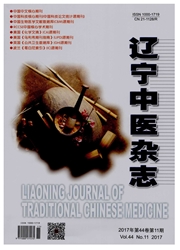

 中文摘要:
中文摘要:
目的:探讨绝经后骨量异常患者表现的症状与骨密度不同阶段之间的相关关系。方法:在社区招募患者,共入组患者245例,采集相关临床数据,录入并建立数据库,采用卡方检验,分析患者中医症状与骨密度不同阶段之间的关系。结果:将245例绝经后骨量异常患者,按照骨密度的T值,分为骨量减少、骨质疏松、严重骨质疏松三个阶段。按照症状积分排序,症状积分前5位的是腰膝酸软(598分)、骨痛(516分)、下肢拘挛(502分)、畏寒肢冷(474分)。其中下肢拘挛与骨密度不同阶段存在一定关系,且有统计学差异(P〈0.05)。腰膝酸软、骨痛、畏寒肢冷、健忘与骨密度不同阶段相关性没有统计学差异(P〉0.05)。结论:绝经年限和BMI指数都是影响骨密度的重要因素;下肢拘挛与骨密度存在相关关系,可以尝试作为早期诊断绝经后骨质疏松症的参考指标之一。
 英文摘要:
英文摘要:
Objective:To study the relationship between symptoms of PMOP and bone mineral density(BMD). Methods:Therewere 245 patients enrolled in the community, then we collected and inputed clinical data and established database. The chi-square test was used to observe the relationship between clinical symptoms and bone mineral density. Results :245 cases of abnormal bone mass in postmenopausal patients, according to T-bone mineral density values were divided into three stages:bone loss, osteoporo- sis, severe osteoporosis. According to symptom scores : weak waist ( 598 points ), pain ( 516 points ), lower limb spasm ( 502 points ) , aversion to cold (474 points). There was a certain relationship between lower limb spasm and the different stages of BMD and there was significant difference (P 〈 0. 05 ). Waist and knee weakness, bone pain, aversion to cold and forgetfulness associated with different stages of bone mineral density were not statistically significant ( P 〉 0. 05 ). Conclusion : Leg cramps have relations with BMD and leg cramps can be the reference indicator of early diagnosis.
 同期刊论文项目
同期刊论文项目
 同项目期刊论文
同项目期刊论文
 Variable selection using the optimal ROC curve: An application to a Traditional Chinese Medicine stu
Variable selection using the optimal ROC curve: An application to a Traditional Chinese Medicine stu 期刊信息
期刊信息
